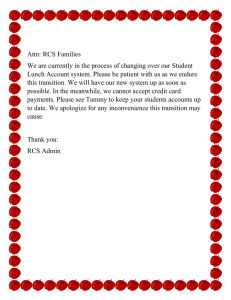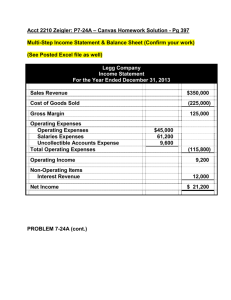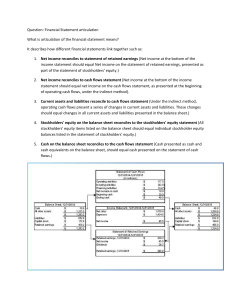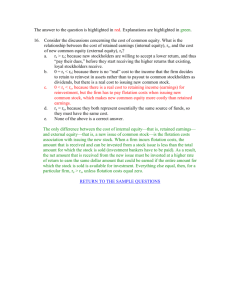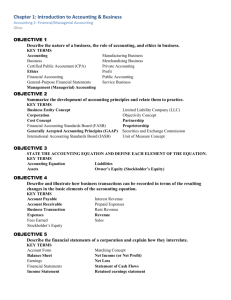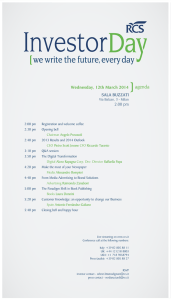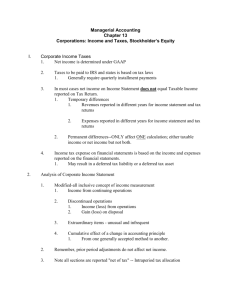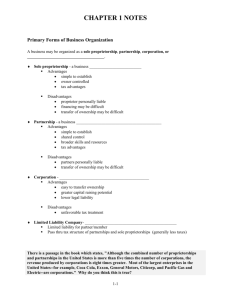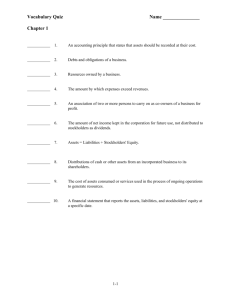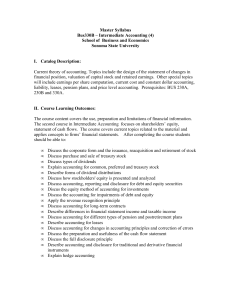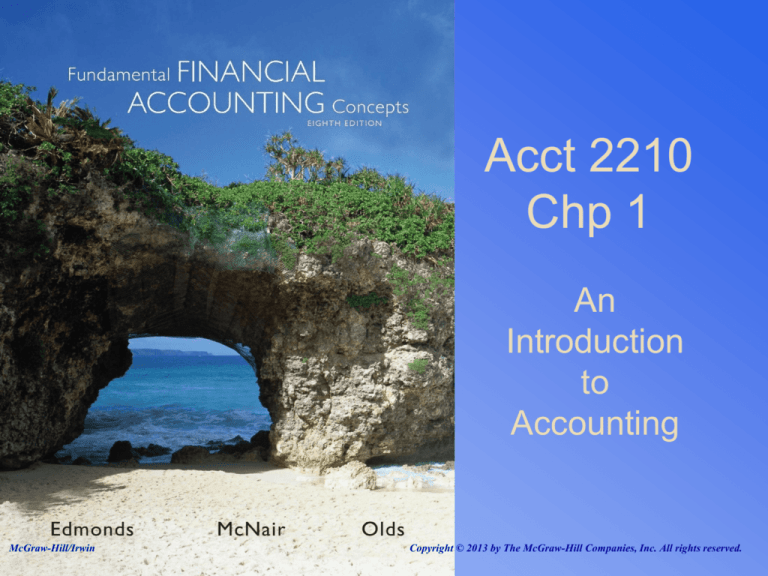
Acct 2210
Chp 1
An
Introduction
to
Accounting
McGraw-Hill/Irwin
McGraw-Hill/Irwin
Copyright © 2013 by The McGraw-Hill Companies, Inc. All rights reserved.
LO 1
Explain the role
of accounting
in society.
1-1
Role of Accounting in Society
Accounting
provides
information that
is useful in
answering
questions about
resource
allocation.
Should I
invest money
in IBM or
General
Motors?
1-2
Market-Based Allocations
A market is a
group of people
or entities
organized to
exchange items
of value.
1-3
1-4
Market-Based Allocations
Common terms for the added value
created in the transformation process:
Profit
Income
Earnings
1-5
Financial Resources
Conversion agents need financial resources
(money) to establish and operate their
businesses.
Investors
Creditors
1-6
Physical Resources
In their most primitive
form, physical
resources are called
natural resources.
Owners of physical
resources seek to sell
those resources to
profitable businesses
which are able to pay
higher prices and make
repeat purchases.
1-7
Labor Resources
Labor resources include
both intellectual and
physical labor.
Workers seek
relationships with
businesses that have
high earnings potential
because these
businesses are better
able to pay high wages.
1-8
Types of Accounting Information
Financial
Accounting
Focused on the
needs of external
users
Managerial
Accounting
Focused on the
needs of internal
users
1-9
Non-business Resource
Allocation
Not all entities allocate resources based on
profitability. Organizations that are not motivated
by profit are called not-for-profit entities.
Government,
foundations, religious
groups, the Peace
Corps, and various
benevolent
organizations allocate
resources based on
humanitarian concerns.
1-10
1-11
Careers in Accounting
Public
Accounting
Private
Accounting
Certified Public Accountant
Audit services
Tax services
Consulting services
Certified Management
Accountant
Certified Internal Auditor
1-12
Measurement Rules
Accountants establish measurement
and reporting rules that businesses use
to facilitate communication.
FASB
Generally
Accepted
Accounting
Principles
1-13
Reporting Entities
Financial accounting
reports disclose the
financial activities of
particular individuals or
organizations described
as reporting entities.
Each entity is treated as
a separate reporting
unit.
Business
Owner
Bank
1-14
LO 2
Construct an
accounting
equation using
elements of
financial
statements
terminology.
1-15
Elements of Financial
Statements
1. Assets
2. Liabilities
3. Equity
4. Contributed Capital
5. Revenue
6. Expenses
7. Distributions
8. Net Income
9. Gains
10. Losses
The
elements
represent
broad
categories.
We will discuss
elements 1-8 in this
chapter. We will save
elements 9 and 10 for
a later chapter.
1-16
Elements of Financial
Statements
1. Assets—Cash, Equipment, Buildings, Land
2. Liabilities
3. Equity
4. Contributed Capital
5. Revenue
6. Expenses
7. Distributions
8. Net Income
9. Gains
Subclassifications
of the elements
are frequently
called accounts.
Accounts are
reported in the
financial
statements.
10. Losses
1-17
Accounting Equation
Claims on the assets are from two sources:
1. Creditors (liabilities)
2. Investors or owners (equity).
1-18
Accounting Equation
Assets =
Liab.
$ 500 = $
Assets
-
$ 500
-
Equity
200 + $
Liab.
$
+
=
300
Equity
200 = $
300
1-19
Accounting Equation
Common Stock + Retained Earnings
1-20
LO 5
Record business
events in general
ledger accounts
organized under an
accounting
equation.
1-21
Recording Business Events Under
the Accounting Equation
Accounting
Event
Transaction
1. Source
2. Exchange
3. Use
1-22
Asset Source Transactions
Businesses obtain assets
from three sources:
1. Owners
2. Creditors
3. Profitable Operations
1-23
Event 1: Rustic Camp Sites (RCS) was formed
on January 1, 2013, when it acquired $120,000
cash from issuing common stock.
1. RCS increases assets
(cash).
Asset Source
Transaction
2. RCS increases
stockholders’ equity
(common stock).
Assets
Acquired Cash through Stock Issue
Double-Entry
Bookkeeping
Cash
+
120,000 +
=
Land
n/a
=
=
Liab.
+
N. Pay. +
n/a
+
Stockholders' Equity
C. Stk. +
120,000 +
Ret. Ear.
n/a
Recorded
Twice
1-24
Event 2: RCS acquired an additional $400,000 of
cash by borrowing from a creditor.
1. RCS increases assets
(cash).
Asset Source
Transaction
2. RCS increases liabilities
(notes payable).
Assets
Beginning Balance
Acquired Cash by Issuing Note
Ending Balance
Cash
120,000
400,000
520,000
+
+
+
+
Land
n/a
n/a
n/a
=
Liab.
+
Stockholders' Equity
=
=
=
=
N. Pay.
n/a
400,000
400,000
+
+
+
+
C. Stk.
120,000
n/a
120,000
+
+
+
+
Ret. Ear.
n/a
n/a
n/a
1-25
Event 3: RCS paid $500,000 cash to purchase land.
1. RCS decreases assets
(cash).
Asset
Exchange
Transaction
2. RCS increases assets
(land).
Assets
Beginning Balance
Paid Cash to Buy Land
Ending Balance
Cash
520,000
(500,000)
20,000
+
+
+
+
=
Land
=
n/a
=
500,000 =
500,000 =
Liab.
+
N. Pay. +
400,000 +
n/a
+
400,000 +
Stockholders' Equity
C. Stk.
120,000
n/a
120,000
+
+
+
+
Ret. Ear.
n/a
n/a
n/a
1-26
Event 4: RCS obtained $85,000 cash by
leasing campsites to customers.
1. RCS increases assets
(cash).
Asset Source
Transaction
2. RCS increases
stockholders’ equity
(retained earnings).
Assets
Beginning Balance
Acquired Cash by Earning Revenue
Ending Balance
Cash
20,000
85,000
105,000
+
+
+
+
Land
500,000
n/a
500,000
=
Liab.
+
Stockholders' Equity
=
=
=
=
N. Pay.
400,000
n/a
400,000
+
+
+
+
C. Stk.
120,000
n/a
120,000
+
+
+
+
Ret. Ear.
n/a
85,000
85,000
revenues
1-27
Event 5: RCS paid $50,000 cash for operating
expenses such as salaries, rent, and interest.
1. RCS decreases assets
(cash).
Asset Use
Transaction
2. RCS decreases
stockholders’ equity
(retained earnings).
Assets
Beginning Balance
Used Cash to Pay Expenses
Ending Balance
Cash
105,000
(50,000)
55,000
+
+
+
+
Land
500,000
n/a
500,000
=
Liab.
+
Stockholders' Equity
=
=
=
=
N. Pay.
400,000
n/a
400,000
+
+
+
+
C. Stk.
120,000
n/a
120,000
+
+
+
+
Ret. Ear.
85,000
(50,000)
35,000
expenses
1-28
Event 6: RCS paid $4,000 in cash dividends to
its owners.
1. RCS decreases assets
(cash).
Asset Use
Transaction
2. RCS decreases
stockholders’ equity
(retained earnings).
Assets
Beginning Balance
Used Cash to Pay Dividends
Ending Balance
Cash
55,000
(4,000)
51,000
+
+
+
+
Land
500,000
n/a
500,000
=
Liab.
+
Stockholders' Equity
=
=
=
=
N. Pay.
400,000
n/a
400,000
+
+
+
+
C. Stk.
120,000
n/a
120,000
+
+
+
+
Ret. Ear.
35,000
(4,000)
31,000
dividends
1-29
Event 7: The land that RCS paid $500,000 to
purchase had an appraised market value of
$525,000 on December 31, 2013.
Historical Cost
Concept
Reliability
Concept
Requires that most
assets be reported at
the amount paid for
them (their historical
cost) regardless of
increases in market
value.
Information is reliable if
it can be independently
verified.
Appraised values are
opinions and will vary
from appraiser to
appraiser.
1-30
LO 4
Classify business
events as asset
source, use, or
exchange
transactions.
1-31
Recap: Types of Transactions
The described transactions have been
classified into one of three categories:
Asset
Source
Increase total
assets,
increase total
claims
Asset
Exchange
Asset
Use
Increase one
asset,
decrease
another
asset
Decrease total
assets,
decrease total
claims
1-32
Summary of Transactions
Assets
Event
1
2
3
4
5
6
7
Cash
+
Land
$
$
120,000
400,000
(500,000)
500,000
85,000
(50,000)
(4,000)
n/a
n/a
$ 51,000 + $ 500,000
=
Liab.
Notes
=
Payable
$
-
+
Stockholders' Equity
Common
+
Stock
$
120,000
Retained
+ Earnings
$
-
Other
Account
Titles
400,000
= $
n/a
400,000
+ $
n/a
120,000
85,000 Revenue
(50,000) Expense
(4,000) Dividend
n/a
+ $ 31,000
Now, let’s prepare the financial statements
for RCS using the data presented above.
1-33
LO 5
Use general
ledger account
information to
prepare four
financial
statements.
1-34
Preparing Financial Statements
RUSTIC CAMP SITES
Income Statement
For the Year Ended December 31, 2013
Rental revenue (asset increases)
$
85,000
Operating expenses (asset decreases)
(50,000)
Net income
$
35,000
{
$
Revenues
exceeded
expenses.
120,000
$Income
120,000is
$
- measured for a
35,000
span of time
(4,000)
31,000
called
the
Net Loss
Beginning common stock
Plus: Common stock issued
Ending common stock
Beginning retained earnings
Plus: Net income
Less: Dividends
Ending retained earnings
Total stockholders' equity
Matching
Concept
Revenues are
matched to
expenses. results when expenses
exceed revenues.
$
151,000
Accounting
Period
1-35
Preparing Financial Statements
RUSTIC CAMP SITES
Income Statement
For the Year Ended December 31, 2013
Revenue (asset increases)
$
85,000
Operating Expenses (asset decreases)
(50,000)
Net Income
$
35,000
RUSTIC CAMP SITES
Statement of Changes in Stockholders' Equity
For the Year Ended December 31, 2013
Beginning Common Stock
$
Plus: Common Stock Issued
120,000
Ending Common Stock
$
Beginning Retained Earnings
$
Plus: Net Income
35,000
Less: Dividends
(4,000)
Ending Retained Earnings
Total Stockholders' Equity
$
120,000
31,000
151,000
1-36
Preparing Financial Statements
RUSTIC CAMP SITES
Balance Sheet
As of December 31, 2013
Assets are
displayed
in order of
liquidity.
Assets
Cash
Land
Total Assets
$
51,000
500,000
Liabilities
Notes Payable
Stockholders' Equity
Common Stock
$
Retained Earnings
Total Stockholders' Equity
Total Liabilities and Stockholders' Equity
$
551,000
$
400,000
$
151,000
551,000
equal
120,000
31,000
1-37
Preparing Financial Statements
RUSTIC CAMP SITES
Statement of Cash Flows
For the Year Ended December 31, 2013
Cash Flows from Operating Activities
Cash Receipts from Revenue
$
85,000
Cash Payments for Expenses
(50,000)
Net Cash Flow from Operating Activities
$
Cash Flows for Investing Activities
Cash Payments to Purchase Land
Cash Flows from Financing Activities
Cash Receipts from Borrowing Funds
400,000
Cash Receipts from Issuing Common Stock
120,000
Cash Payments for Dividends
(4,000)
Net Cash Flow from Financing Activities
Net Increase in Cash
Plus Beginning Cash Balance
Ending Cash Balance
$
Operating
35,000
(500,000)
516,000
51,000
51,000
Investing
Financing
1-38
The Closing Process
Transfers net income
(or loss) and dividends
to Retained Earnings.
Establishes zero
balances in all
revenue, expense, and
dividend accounts.
1-39
Temporary and Permanent
Accounts
Assets
Temporary accounts
track financial
results for a limited
period of time.
Liabilities
Permanent
Accounts
Equity
Temporary
Accounts
Dividends
Expenses
Revenues
Permanent accounts
track financial
results from year to
year.
1-40
LO 6
Record business
events using a
horizontal financial
statements model.
1-41
Horizontal Financial Statements
Model
1-42
Real World Financial Reports
Service
Businesses
Merchandising
Businesses
Manufacturing
Businesses
1-43
Annual Reports
(1) Financial Statements
(2) Notes
(3) Auditor’s Report –Chapter 6
(4) Management’s Discussion
and Analysis (MD&A)
Traditionally, large
companies have distributed
expensive annual reports
with many color
photographs.
Increasingly, however,
companies are issuing
more modest annual
reports or are simply
distributing their 10-K
reports.
1-44
Special Terms in Real-World Reports
The financial statements of real-world companies include
numerous items relating to advanced topics that are not
covered in introductory accounting textbooks.
However, we encourage you to look for annual reports in
the library, from your employer, or on the Internet.
The best way to
learn
accounting is to
use it.
1-45
End of Chapter One
1-46

